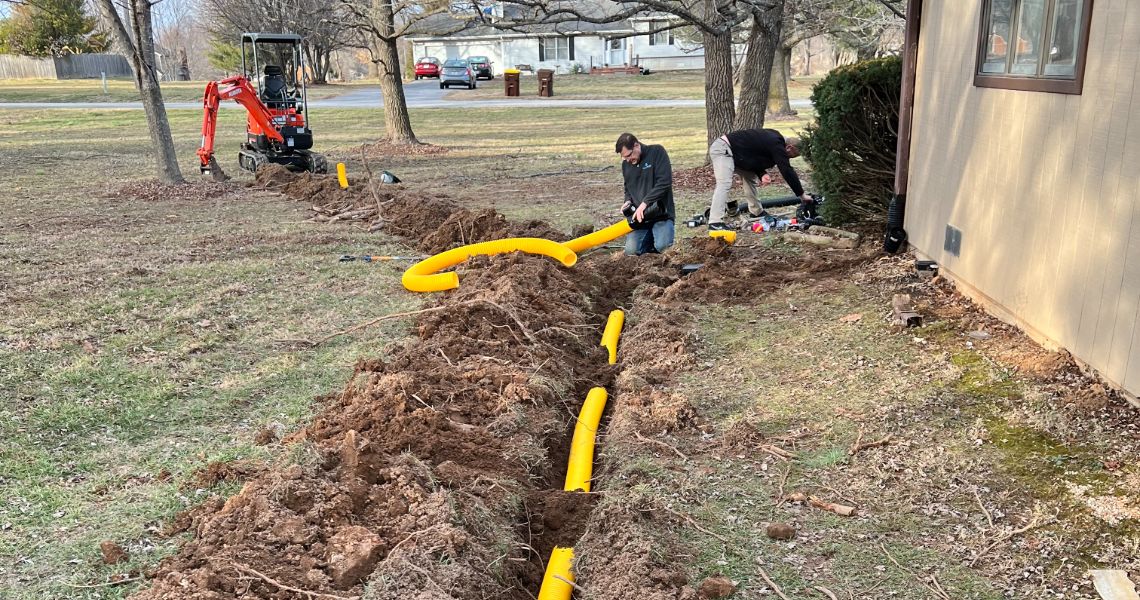
Install A Drain System On Your Home Or Business
GlennStone Roofing in Springfield, MO offers several drainage system solutions in addition to our standard gutter systems, including downspout extensions, splash blocks, and underground trenching services, through our Drainage Specialty division, GlennStone Outdoor Drainage a Certified Professional Drainage Contractor. Each job is carefully evaluated, and a solution-based plan is created for long-term success. Together we can recommend an all-inclusive answer to your water problems, including top-quality Gutter Systems, Gutter Protection, Downspout Drainage Systems, French Drains, Surface Drains, Yard Grading, Berms, Swales and, of course, Roofing because it all starts there!
Why should you invest in a drainage system in addition to your gutters and downspouts?
Most people do not realize the effect of water until it’s too late. Water will flow where it wants to unless it is directed otherwise. Furthermore, water can cause damage to your home even after it has been safely controlled by your gutters and downspouts. In many cases, we find Springfield homes with downspouts discharging directly next to the foundation, usually due to a downspout elbow falling off or simply because the original gutter installer didn’t know better. This water “pooling” effect next to the foundation can be a real problem, especially if the grade around the home is poor. This can lead to additional hydrostatic pressure on the foundation walls.
Underground water creates hydrostatic pressure when it encounters a barrier such as a basement or foundation wall. During heavy rains, the water table rises toward the basement, which creates more hydrostatic pressure and can exert up to 500 pounds per square inch against the home’s foundation.
Over a period of time, this pressure can cause basement walls to bow or crack and lead to water in the basement, mold, and a variety of other problems you don’t need. This has led to the creation of an entire industry dedicated to basement waterproofing, which could cost $30,000 or more to install.
In most cases, this expense can be avoided if you catch the problem in time and invest in appropriate outside water management options, including a functional and proper capacity gutter and downspout system and an underground drainage system.
The best strategy is to direct the water as far away from the foundation as possible. The simplest way to do this is to add downspout extensions to help transport the water away. The homeowner can easily do this purchasing flexible tubing or extra downspout pipe and elbows and simply attaching it to the existing downspouts. The farther away from the foundation, the better; however, many homeowners do not want the pipe lying across the grass because it is unsightly and can get in the way of mowing the lawn.
Installing an underground drainage system is the best long-term approach for directing rainwater away from your foundation. When a property has a substantial slope away from the home, the end of the underground tile may simply be terminated and capped with a grate. However, in situations without a proper slope, a “pop-up” drain may be needed to allow the water to exit in the middle of the lawn.
There are a number of considerations that must be made concerning underground power lines or sprinkler systems, as well as cement or brick paver walkways, which will determine how the trench will be dug. Every situation is different, but the general goal is to safely direct the water as far away as possible.
Contact Our Drainage Experts In Springfield MO
The need for a quality, certified contractor to provide Drainage Services, including French Drains, Downspout Drainage Systems, and Yard Grading, was so great that GlennStone LLC created GlennStone Outdoor Drainage. This division of GlennStone LLC focuses solely on rainwater issues in residential and light commercial settings.

